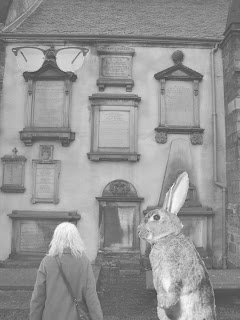How many Freudian analysts does it take to hang a penis? I mean my mother…I mean a painting!
The answer is all in the mind. When we make art, we reveal the innermost workings of our psyche. Look at my embroidered samplers and you can clearly see my mental bits and pieces. Apparently.
At the art-school I decline to name, a certain lecturer was very keen on art and psychology, and during lectures on the subject revealed details of her own neuroses, dramatic epiphanies reached after much gruelling and intense psycho-analysis. Amongst other afflictions, she admitted to being an hysteric, although had she crossed my palm with silver, I could have told her that ten seconds after meeting her.
But look, it’s all about being deep, and revealing yourself in your work. And so we reach confessional art, and of course must refer to Tracy Emin who, with her unmade bed and other stylised personal outpourings looms large. Hang on - why do I mention her so much, when I’m not a huge fan of her work? It’s odd, but she does keep recurring. Mummy! Why were you so cold? Ah, that’s better!
Anyway, obviously when you put yourself into your work, you can’t help but reveal some of your innermost thoughts. I pause now and take a deep cleansing breath, remembering that I frequently draw bunny rabbits. How does that make me feel? What’s up doc?
Back to my point, though. There is the work of the crazy kitten man, for starters. He drew lovely cute cats, but was sectioned in what was then called an insane asylum when he went mad (...pauses for readers to say because he painted cats…) and his mental torment showed in his work. Cats, previously portrayed as idealised creatures living pampered lives in a paradise of slow-moving mice and bowls of cream were painted looking distressed and surrounded by jagged lightening halos. Yes, he was trying to tell the world something, but don’t worry he recovered, once more to draw pretty, happy cats.
We have surrealists like Dali and all those other artists who begin their conversations ‘last night I dreamed about etc.’ But you switch off because they are boring (other people’s dreams usually are) only they get Turner nominated and have dedicated South Bank Show Specials and I’m not bitter or anything.
I don’t know how to reveal more about myself. I tell people, as honestly as possible can why and how I choose my subject matter. Except again this isn’t how it works. You have to complete your work, and then even if it contains the slogan: ‘I am well mad, me!’ observers make their own interpretation. It’s like the dream I had last night where I was naked but I couldn’t move in the train station, and people were staring and pointing. There was a giant bunny rabbit! Help me!
Oh, good grief. Shall we let it pass? Good art is based on ideas. It usually reveals something about the artist. I’m off now to draw lot’s and lot’s of bananas and cucumbers. Stop looking at me like that.









